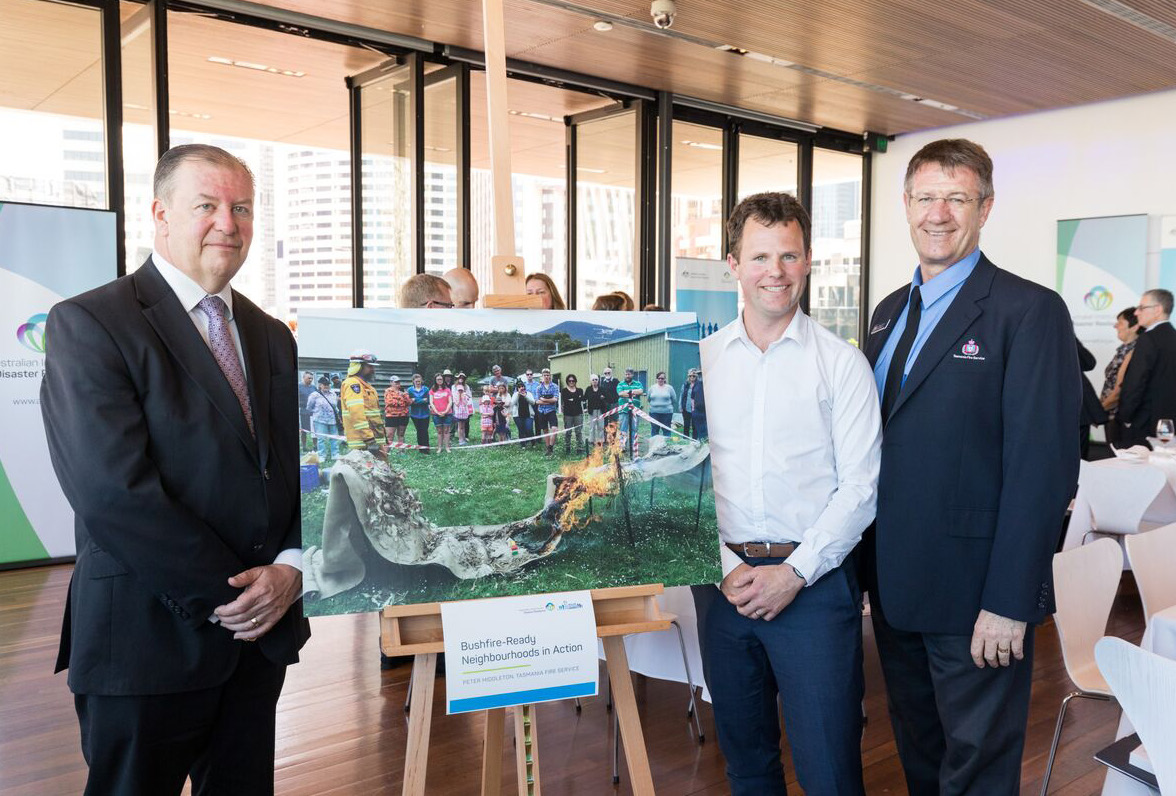The 2017 National Resilient Australia Awards were characterised by success built through collaboration. The City of Mandurah in Western Australia saw the regional reach in a project officer’s vision to increase preparedness in a community of interest. Two time zones away, Sydney’s St. Ives North Public School brought community, students and emergency services together to teach STEM through the lens of bushfire risk and management. In Airlie Beach, Queensland, an image of a family’s perseverance and strength in the face of disaster became a symbol of community resilience.
Equi-Evac Centre Network
City of Mandurah
The Resilient Australia National Award was presented to City of Mandurah in Western Australia for the Equi-Evac Centre Network, a project described by the judges as ‘a novel approach to engagement and collaboration.’ The project equipped local public equestrian facilities as evacuation points for the surrounding community of horse owners in times of emergency. The Equi-Evac Centre Network emerged out of tertiary study in emergency management undertaken by former City of Mandurah project officer Naomi Dekker. Although her local equestrian community was already closeknit, Dekker identified an opportunity to enhance preparedness for emergencies—the 2016 Waroona-Harvey bushfires had demonstrated the unsuitability of pounds and other public welfare centres as evacuation points.
Through the project, public equestrian facilities deemed suitable were provided with a comprehensive activation kit including guidelines, contacts, equipment and information on welfare standards. Dekker worked closely with the community to develop consistency in procedures, fostering greater engagement and ownership.
The City of Mandurah played a key role in recognising the value and potential reach of Dekker’s work, and facilitating its implementation across the Peel and south-west regions in Western Australia. Specifically, the City worked with 14 other local governments and the community, engaging state and national bodies including the Department of Fire and Emergency Services—the state lead for bushfire management—the Department for Communities, the Department of Agriculture and Food, the Australian Red Cross and the Royal Society for the Prevention of Cruelty to Animals. Myra Giardini, Emergency Management Coordinator at the City of Mandurah, identified the importance of the work being tailored to the equestrian community, echoing broader national conversations around inclusive evacuation planning. She also attributed the success of the project to its facilitation of meaningful connection between government and community; a characteristic also recognised by the judges as key to its ongoing sustainability. Mandurah Mayor Rhys Williams celebrated the project for ‘empowering people to bring their solutions forward,’ describing the work as a ‘good example of what happens when you trust the community to be part of the process.’
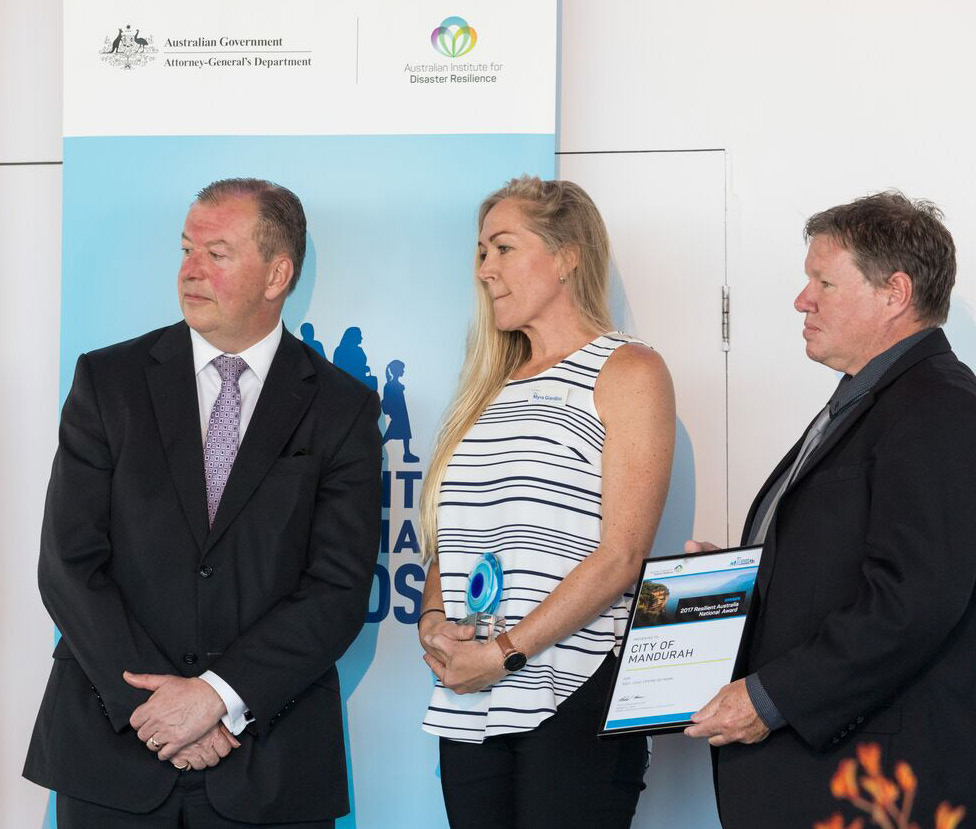
Bernie Hobbs, Master of Ceremonies, Mark Crosweller, Emergency Management Australia, Myra Giardini and Councillor Darren Lee, City of Mandurah. Image: Australian Institute for Disaster Resilience
Flooded Roads Smart Warning System
Logan City Council
One of many parts of eastern Australia prone to flooding, Logan City Council in Queensland was highly commended for the development and implementation of the Flooded Roads Smart Warning System. The project deployed warning signs powered by recycled laptop batteries, to prevent drivers inadvertently crossing flooded roads. The initiative was developed by Logan City Council in partnership with Griffith University and social enterprise Substation 33, benefiting participants through work experience and the opportunity to apply academic learning in a hands-on context. Involvement of Substation 33 saw the project adopt the laptop batteries in place of acid batteries, generating significant efficiencies through increased power, and reducing size and cost.
The region had previously seen numerous incidents of drivers attempting to cross floodwaters, which had resulted in water rescues, and in some cases tragedy. However, when Tropical Cyclone Debbie hit Logan following roll out of the signs, there were no reports of drivers entering floodwaters.
Project lead Greg Kelly emphasised that ‘saving lives’ was the central motivator behind the work. He described the project as a ‘social, environmental and economic solution,’ and expressed confidence in the transferability of the system to other jurisdictions. The judges described the project as a ‘creative example of how risk can be treated using a low-cost solution.’
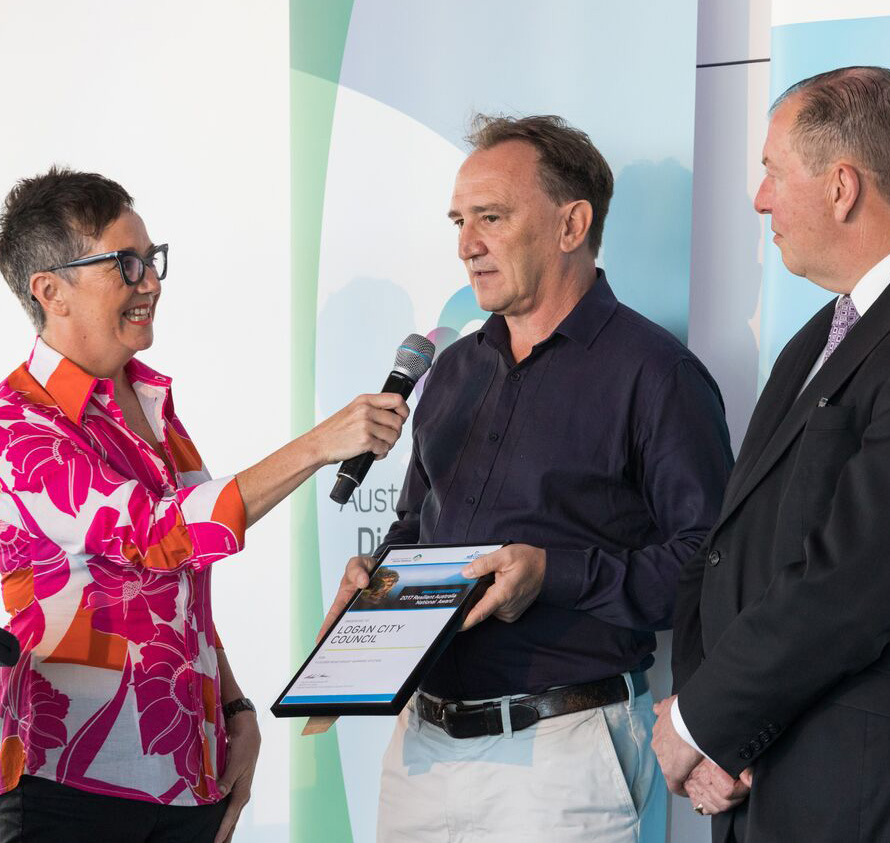
Bernie Hobbs, Master of Ceremonies, Greg Kelly, Logan City Council and Mark Crosweller, Emergency Management Australia. Image: Australian Institute for Disaster Resilience
Emergency Ready Communities
Melton City Council & Wyndham City Council
The value of social capital was also at the heart of the highly commended Emergency Ready Communities project, led by Andrew Mason and jointly implemented by Melton City Council and Wyndham City Council in the outskirts of Melbourne, Victoria. The project comprised a multifaceted approach to fostering disaster resilience, through leadership training, authentic community engagement and initiatives led by community members with tailored council support.
A key element of the project was the development of a new model for targeting engagement towards influencers across communities. The model sought to more accurately represent the nuanced interactions within communities, recognising complexity and transcending simplistic demographic segmentation. A number of community members were also supported to participate in a leadership training program, through which they led a range of local resilience projects—11 project briefs were subsequently published in a prior edition of this journal.
The Emergency Ready Communities project culminated in a forum targeted to a broad cross-section of community influencers and representatives using the newly developed model. As part of the forum, participants took an active role in assessing the resilience of their community using a scorecard developed by the Torrens Resilience Institute. The judges recognised the innovation in the project, describing the forum as a ‘first of its kind.’
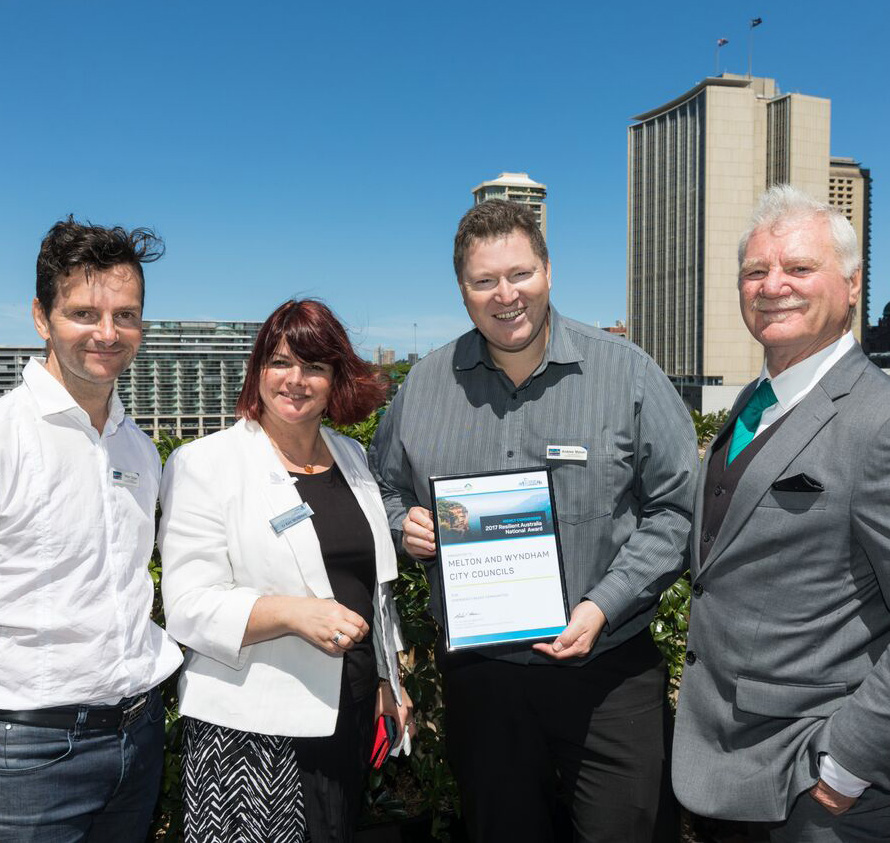
Peter Doyle, City of Melton, Councillor Kim McAliney, City of Wyndham, Andrew Mason and Councillor Ken Hardy, City of Melton. Image: Australian Institute for Disaster Resilience
Project FireStorm
St. Ives North Public School
The Resilient Australia National School Award was presented to Sydney’s St. Ives North Public School in recognition of Project FireStorm, an exemplary program that integrated STEM and disaster resilience education. The project saw the primary school partner with NSW Rural Fire Service (NSW RFS), utilising problem-based learning strategies to deliver bushfire education as a component of the new geography syllabus. From bunkers to robotics, students explored creative solutions to protect and prepare the community of St. Ives; the school’s IT and STEM Coordinator Sean Walsh emphasised that students were encouraged to see themselves as ‘active agents of change’ in community preparedness. Assistant Principal Barbara Ryan described the students’ enthusiasm as ‘contagious,’ and highlighted the importance that their ideas were ‘valued and heard.’ She spoke of the importance of demonstrating the students’ potential to the wider community, as part of fostering greater unity and resilience.
NSW RFS Community Engagement Coordinator Tony Jarrett described the NSW RFS role as a ‘critical yet supportive audience’—as the ‘authentic partner’ of the project, the NSW RFS were a key source of knowledge to guide student thinking. Jarrett described the result as a ‘ripple-up’ effect, as the student experience permeated families and the broader community. This reach was also identified by the judges as key to the project’s value. The influence of Project FireStorm was also apparent throughout the state—the project is now utilised as a case study to support other teachers and schools to deliver meaningful bushfire education, fulfilling the vision of the Resilient Australia Awards as an inspiration and example to other communities.
The award was accepted by students Vincent Chen and Taylor Warnes on behalf of the school and their cohort; both expressed pride in the result and affirmed the value of the educational experience. Warnes identified the supportive influence of both teachers and the NSW RFS in the program, and the value of the work for the school community into the future.
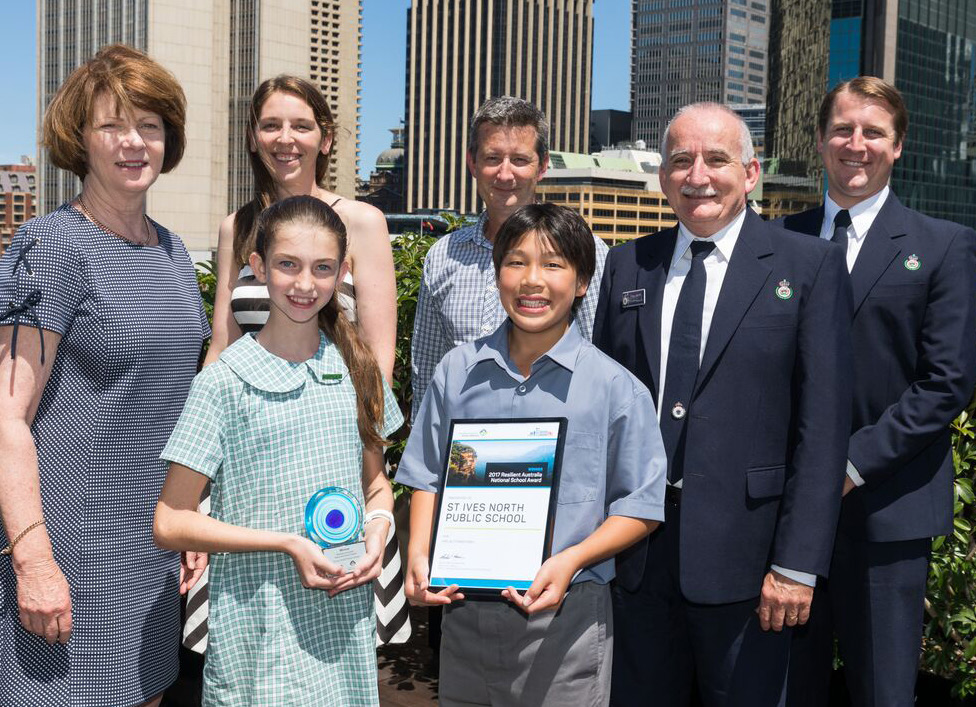
L-R: Barbara Ryan, Yolande Curby, Taylor Warnes & Vinson Chen (students), Sean Walsh, St. Ives North Public School, Tony Jarrett, Anthony Bradstreet, NSW Rural Fire Service. Image: Australian Institute for Disaster Resilience
Rebuilding Dunalley Primary School after the 2013 Bushfires Project
Dunalley Primary School
Tasmania’s Dunalley Primary School was highly commended for the Rebuilding Dunalley Primary School After the 2013 Bushfires Project. The award acknowledged a mammoth cross-sector recovery effort, in the wake of devastating fires which destroyed the school along with the township’s police station and bakery. In the aftermath, local government worked together with emergency services, the school community and local business—including an important volunteer contingent—to construct a temporary facility for the town’s 120 primary school students and their teachers. The timely completion of the project saw the school reopen only a few short days after the scheduled beginning of term, minimising disruption to education.
Dunalley Primary School Principal Susan Jeffery reflected on the effort as an embodiment of ‘resilience, determination, persistence and people pulling together from all different sectors to create a positive future.’ For Jeffery, the award was an important recognition of the community’s recovery journey over the years following the disaster. She also emphasised the shared vision integral to the project’s success—the shared commitment to young people’s education which had brought together representatives across the sectors. The judges were moved by the cooperation the project embodied, and celebrated the Dunalley community for their work to deliver ‘hope and positive results.’
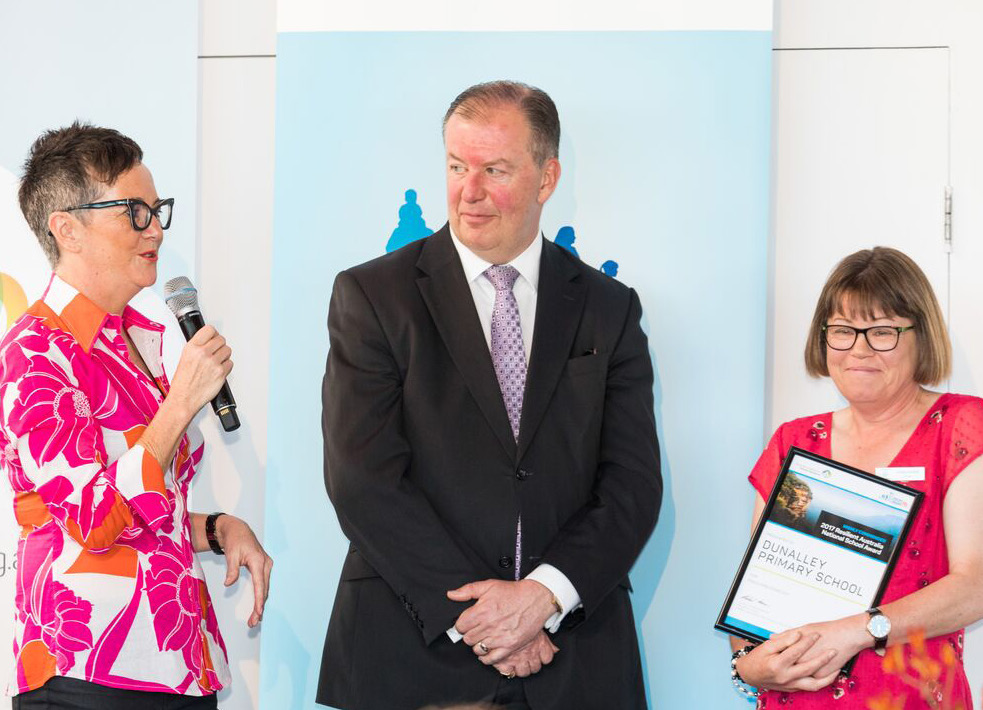
Bernie Hobbs, Master of Ceremonies, Mark Crosweller, Emergency Management Australia, Susan Jeffery, Dunalley Primary School. Image: Australian Institute for Disaster Resilience
Strathewen Education Partnership Claymation
Strathewen Primary School and Arthur’s Creek/Strathewen Country Fire Authority
The Strathewen Education Partnership-Claymation project was also highly commended in the schools category. Strathewen is situation in a fire-prone part of regional Victoria, and the community had experienced the destructive impact of the Black Saturday bushfires first-hand including the loss of the school building. The Partnership-Claymation project was driven by a vision for students to ‘love where they live again.’ The project was delivered as part of the Country Fire Authority’s Survive and Thrive program, and saw students of Strathewen Primary School work with the Arthur’s Creek/Strathewen Country Fire Authority to develop a greater knowledge of fire risk, behaviour and management. Specifically, the project educated students about Fire Danger Rating in Victoria, including characteristics in their environment associated with different ratings. Students also learnt about information channels for bushfire warnings, and appropriate preparedness measures to undertake based on the risk.
The educational program culminated in a Claymation video produced by the students, which details appropriate preparedness measures. The creative platform allowed students to capture and communicate their learning to family and community; students also led elated workshops. The value of the video as an engaging medium was affirmed by students who represented the school at the national awards. The project was described by the judges in terms of student empowerment through knowledge and skills.

Lisal O’Brien, Arthur’s Creek CFA, Rose Hammett, Charlotte Adams, Noah Harrison, Ruby Bradshaw, Harry McLean, Strathewen Primary School (students) and Jane Hayward, Strathewen Primary School. Image: Australian Institute for Disaster Resilience
First Sight of Relief
Summer Rain Photography
Summer Mulvey of Summer Rain Photography received the National Photography Award for her poignant image ‘First Sight of Relief.’ The photo captures Mulvey’s three young children looking on as an excavator clears the road to the family’s remote Brandy Creek home, in the Airlie Beach area of Queensland. In the wake of Category 4 Tropical Cyclone Debbie, the family were stranded for three days without running water, power or road access. Though Mulvey and her family were prepared with safety precautions and had endured several cyclones in a decade spent on the property, Debbie’s fury was like nothing in their experience.
However, the family were resourceful and tenacious throughout the chaos, illustrated in Mulvey’s recollection of the family collecting rainwater dripping from the roof, and her efforts to contact neighbours over the two-way radio and relay information to council recovery workers. In the disaster’s immediate aftermath, the Brandy Creek community rallied together to meet each other’s needs: neighbours in radio contact passed messages of reassurance from the Mulvey family to their loved ones, and community members exchanged essential supplies as road access was gradually restored. Reflecting on the photo’s impact, Mulvey spoke of its emotional resonance with others who had experienced the disaster first-hand.
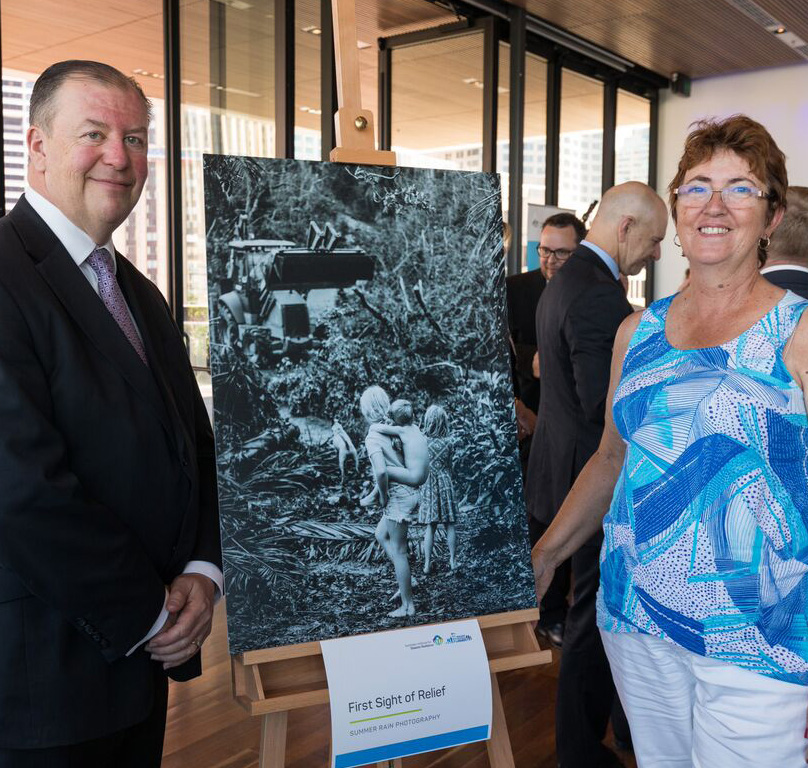
Mark Crosweller, Emergency Management Australia and Heather Brown, Brandy Creek resident. Image: Australian Institute for Disaster Resilience
Bushfire-Ready Neighbourhoods in Action
Peter Middleton, Tasmania Fire Service
Peter Middleton of the Tasmania Fire Service (TFS) was highly commended for his image ‘Bushfire-Ready Communities in Action.’ The photo captures a TFS firefighter engaging members of Tasmania’s Lachlan community, through a dynamic demonstration of the ferocity with which a fire can take hold. The demonstration was delivered as part of the Bushfire-Ready Communities program, a central TFS community engagement initiative. The Bushfire-Ready Communities program is implemented in communities on a tailored basis; activities ranging from information sessions to practical demonstrations are delivered based on interest and degree of risk.
